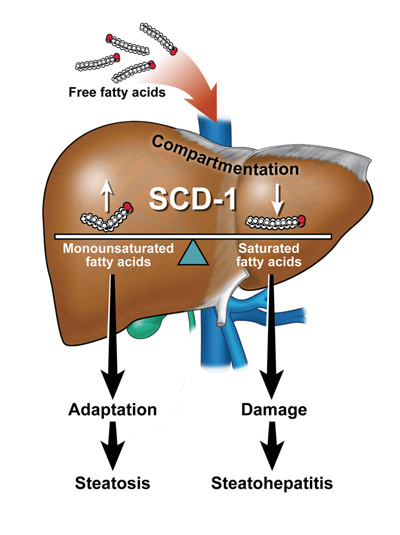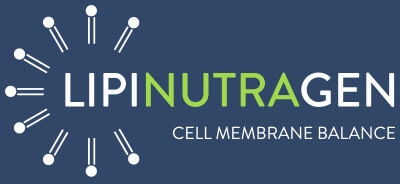
LIPIDOMICS AND HEPATOCYTE FUNCTIONING

Enzyme reactions and fatty acids
The liver is the main organ deputed to the synthesis of fatty acids (lipogenesis); it has the “vocation” of initiating the cascade of enzymatic reactions provided for lipogenesis. Without fats, no cell can live, and for this reason, the liver is an indispensable organ.
Lipogenesis involves three consecutive stages (see figure):
- the ex-novo synthesis of palmitic acid, a saturated fatty acid (16 carbon atoms);

- the two-unit elongation reaction of the palmitic acid structure, transformed into stearic acid (18 carbon atoms). Palmitic acid and stearic acid are the two main saturated fatty acids in our cells, and the cell membrane of the hepatocyte (as shown in the table in the article www.lipinutragen.it/en/liver-and-its-cells-hepatocytes/) also has an amount of up to 40-45% of its total components;
- the subsequent transformation, which is very important and necessary precisely for hepatic metabolism, of stearic acid into oleic acid (monounsaturated fatty acid with 18 carbon atoms) by insertion of a double bond (in technical terms, enzymatic desaturase; see figure shown as delta-9 desaturase or SCD-1).
It is highlighted that saturated fats, although necessary for the formation of cells and the cell membrane, must necessarily be transformed into monounsaturated fats to allow the two components (saturated and monounsaturated) to mix and ensure adequate flow and permeability properties, which are necessary for vital functions.
Hepatic metabolism and membrane composition

In hepatic metabolism, transformation takes on particular significance, as seen in the figure taken from a major review in 2009 [1]. In fact, the ability to “desaturate” has an impact on adaptation and metabolic flexibility of the liver cell.
If the hepatocyte contains sufficient proportions of monounsaturates, the cell membrane remains functional for metabolism, allows adaptation to all demands, and if the fat load increases, lipid accumulation evolves into a condition of steatosis, but without destructive effects.
In the case of impediment of saturated fat transformation, on the other hand, there is an increase in the saturated component over the monounsaturated component, with structural change of the hepatocyte and consequent cellular damage, corresponding to a condition of steatohepatitis. In this condition, there will also be an imbalance in favor of inflammatory-type signaling, which increases the destructive rather than regenerative potential of this very important cell.
Lipidomic analysis and liver status interpretation
To know how the liver is functioning, whether it is in metabolic homeostasis or whether it has developed metabolic or inflammatory issues, health experts have at their disposal an analytical tool that accurately reports the composition of the hepatocyte: lipidomic analysis of the mature red blood cell (performed in our Lipidomics Laboratory with exclusive robotic equipment, according to ISO 17025 accredited method).
The molecular information present in the outcome of membrane lipidomic analysis is the complementary aspect to biochemical-clinical (for GOT-GPT-ALT transaminase values, C-reactive protein, etc.) and diagnostic (such as ultrasonography) examinations to assist therapeutic and/or nutritional strategies.
Only by supporting the balance of the lipid pool can the regenerative potential of the hepatocyte be fully expressed, sustaining metabolic demands at all ages and occasions (as described in the article www.lipinutragen.it/en/liver-and-its-cells-hepatocytes/).
Essential bibliography:
[1] Alkhouri,N.; Dixon, L.J.; Feldstein, A.E. Lipotoxicity in Nonalcoholic Fatty Liver Disease: Not All Lipids Are Created Equal Expert Rev Gastroenterol Hepatol. 2009, 3, 445–451
[2] Ferreri, C.; Chatgilialoglu, C. Membrane Lipidomics for Personalised Health, page 39, Wiley, 2015
Read more in LipiMagazine:
- NON-ALCOHOLIC HEPATIC STEATOSIS: www.lipinutragen.it/en/liver-organ-not-to-be-overloaded/
- THE SCIENTIFIC VALIDITY OF MEMBRANE LIPIDOMICS: www.lipinutragen.it/en/lipidomic-membrane-analysis/
Article edited by the Lipinutragen Editorial Group in collaboration with Dr. Carla Ferreri, CNR Director in Bologna and Scientific Director of Lipinutragen
The information reported should in no way replace the direct relationship between health professional and patient.
Photo: 123RF Archivio Fotografico: 178359670 : ©mol4un
- On 27 June 2023



